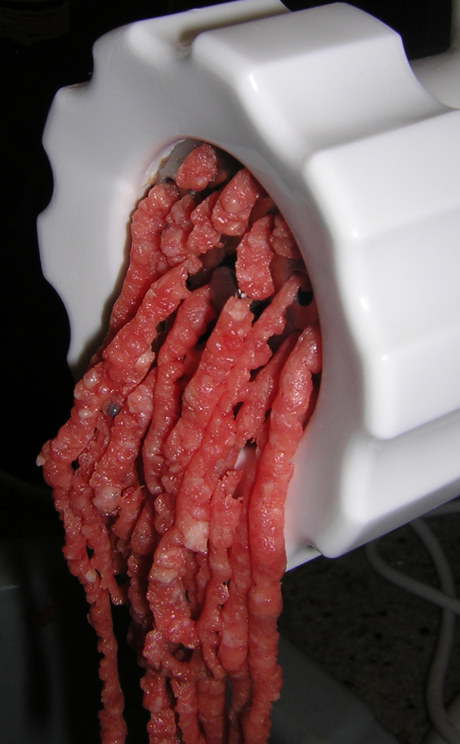About 18 months after the 1993 Jack-in-the-Box E. coli O157:H7 outbreak, I, the erstwhile graduate student, gave a talk to a bunch of food safety types from government and industry. I showed a clip from ABC’s 20/20 television program about a family fighting for regulatory change, and many in the audience laughed at the family when their kitchen was shown. Audience members commented that the consumers were sloppy in their cooking and of course they got sick, and if only they would cook hamburger properly E. coli O157:H7 wouldn’t happen.
.jpg) I thought the response of the audience was sort of appalling.
I thought the response of the audience was sort of appalling.
In mid-1994, Michael Taylor was appointed chief of USDA’s Food Safety and Inspection Service. On Sept. 29, 1994, USDA said it would now regard E. coli O157:H7 in raw ground beef as an “adulterant,” a substance that should not be present in the product. By mid-October, 1994, Taylor announced plans to launch a nationwide sampling of ground beef to assess how much E. coli O157:H7 was in the marketplace. The 5,000 samples would be taken during the year from supermarkets and meat processing plants “to set an example and stimulate companies to put in preventive measures.” Positive samples would prompt product recalls of the entire affected lot, effectively removing it from any possibility of sale.
That’s the long-winded version for what a USDA official said in a 1994 television interview: we’ll stop blaming consumers when they get sick from the food and water they consume.
But the just-cook-it crowd persisted. And still does today.
A couple of weeks ago, while announcing a ground beef recall in Colorado, the U.S. Department of Agriculture’s Food Safety Inspection Service stated in a release,
FSIS would like to remind consumers of the importance of following food safety guidelines when handling and preparing raw meat. Ground beef should be cooked to a safe minimum internal temperature of 160° Fahrenheit.
.jpg) I would like to remind FSIS that it ain’t so easy to handle contaminated ground beef and not spread it around a home or food service kitchen.
I would like to remind FSIS that it ain’t so easy to handle contaminated ground beef and not spread it around a home or food service kitchen.
Jim Marsden, a former vp at the American Meat Institute and now a professor at Kansas State University, wrote in his meatingplace.com blog last week, the top-10 reasons “just cook it” does not, and will not, work.
1. E. coli O157:H7 is a unique pathogen. The levels of this organism necessary to cause infection are very low.
2. The severity of the disease E. coli O157:H7 can cause, especially in children is devastating.
3. In many cases, parents order hamburgers for their children and rely on restaurants to cook them properly. In restaurants, parents really have no control over whether the hamburgers they order are sufficiently cooked to eliminate possible contamination from E. coli O157:H7.
4. If consumers unknowingly bring this pathogen into their kitchens, it is almost impossible to avoid cross contamination. Even the smallest amount of contamination on a food that is not cooked can cause illness. Many of the reported cases of E. coli O157:H7 have involved ground beef that was clearly cooked at times and temperatures sufficient to inactivate E. coli O157:H7. Some other vector, i.e. cross contamination was probably involved.
5. Even if consumers attempt to use thermometers to measure cooking temperature, it is difficult to properly measure the internal temperature of hamburger patties. They would have to use an accurate thermometer and place the probe exactly into the center of the patty. In addition, the inactivation of E. coli O157:H7 is dependent on cooking time and temperature. For example, if they cook to 155 degrees F, they should hold that temperature for 16 seconds. It is not realistic to expect that consumers, many of which are children will scientifically measure the internal temperature of hamburgers.
6. The way ground beef is packaged, it is virtually impossible to remove it from packages or chubs and make patties without spreading contamination if it is present.
7. Sometimes ground beef appears to be cooked when it really isn’t. There is a phenomenon called “premature browning” that can make ground beef appear to be fully cooked when in fact it is undercooked.
8. E. coli O157:H7 may be present in beef products other than ground beef. For example, in non-intact beef products, including tenderized steaks that are not always cooked to temperatures required for inactivation.
9. There have been many cases and outbreaks of E. coli O157:H7 associated with foods that are not cooked (i.e. fresh cut produce).
10. As Senator Patrick Leahy said after the 1993 Jack-in-the-Box outbreak – “The death penalty is too strong a punishment for undercooking a hamburger”. He was right –consumers will make mistakes. There needs to be a margin of safety so that undercooking does not result in disease or death.


 From the newspaper:
From the newspaper: .jpg) — Appointed a chief medical officer within USDA’s Food Safety Inspection Service to coordinate human health issues within USDA and build bridges with the public health community and senior leaders throughout the federal, state and local sectors to establish a consistent approach and heighten food safety awareness.
— Appointed a chief medical officer within USDA’s Food Safety Inspection Service to coordinate human health issues within USDA and build bridges with the public health community and senior leaders throughout the federal, state and local sectors to establish a consistent approach and heighten food safety awareness..jpg) Too often it is. As Michael Moss wrote in The Times recently, E. coli sickens thousands of people annually, including a young dance teacher named Stephanie Smith, who was paralyzed after eating a contaminated hamburger. Her case offers a poignant reminder that President Obama and Congress need to quickly fill the safety gaps in food production. …
Too often it is. As Michael Moss wrote in The Times recently, E. coli sickens thousands of people annually, including a young dance teacher named Stephanie Smith, who was paralyzed after eating a contaminated hamburger. Her case offers a poignant reminder that President Obama and Congress need to quickly fill the safety gaps in food production. … Costco’s food safety director and seemingly decent dude, Craig Wilson, said the company would begin buying beef trimmings for making hamburger from Tyson, one of the largest beef producers, after an agreement reached with Tyson this week that allows Costco to test the trimmings before they are mixed with those from other suppliers.
Costco’s food safety director and seemingly decent dude, Craig Wilson, said the company would begin buying beef trimmings for making hamburger from Tyson, one of the largest beef producers, after an agreement reached with Tyson this week that allows Costco to test the trimmings before they are mixed with those from other suppliers.
.jpg) I thought the response of the audience was sort of appalling.
I thought the response of the audience was sort of appalling..jpg) I would like to remind FSIS that it ain’t so easy to handle contaminated ground beef and not spread it around a home or food service kitchen.
I would like to remind FSIS that it ain’t so easy to handle contaminated ground beef and not spread it around a home or food service kitchen..jpg) As a result of an ongoing investigation into an outbreak of Salmonella Typhimurium DT104 associated with ground beef products, the Colorado Department of Public Health and Environment (CDPHE) notified FSIS of the problem. Epidemiological investigations and a case control study conducted by CDPHE and the Centers for Disease Control and Prevention (CDC) determined that there is an association between the fresh ground beef products and 14 illnesses reported in Colorado. The illnesses were linked through the epidemiological investigation by their less common pulsed-field gel electrophoresis (PFGE) pattern found in PulseNet, a national network of public health and food regulatory agency laboratories coordinated by the CDC.
As a result of an ongoing investigation into an outbreak of Salmonella Typhimurium DT104 associated with ground beef products, the Colorado Department of Public Health and Environment (CDPHE) notified FSIS of the problem. Epidemiological investigations and a case control study conducted by CDPHE and the Centers for Disease Control and Prevention (CDC) determined that there is an association between the fresh ground beef products and 14 illnesses reported in Colorado. The illnesses were linked through the epidemiological investigation by their less common pulsed-field gel electrophoresis (PFGE) pattern found in PulseNet, a national network of public health and food regulatory agency laboratories coordinated by the CDC..jpeg) “There is no question that the United States has the safest food supply in the world and other countries consider the U.S. the ‘gold standard.’ Cattle producers support the establishment of realistic food safety objectives designed to protect public health to the maximum extent possible.
“There is no question that the United States has the safest food supply in the world and other countries consider the U.S. the ‘gold standard.’ Cattle producers support the establishment of realistic food safety objectives designed to protect public health to the maximum extent possible.  The beef products were produced on April 21, 2009 and were distributed both nationally and internationally.
The beef products were produced on April 21, 2009 and were distributed both nationally and internationally.  In two of the cases, children consumed kofta purchased on June 14 and 15 from the store. The source of the third child’s infection has not been identified, but the child’s family also eats halal food, although it didn’t purchase any from the Westmount store.
In two of the cases, children consumed kofta purchased on June 14 and 15 from the store. The source of the third child’s infection has not been identified, but the child’s family also eats halal food, although it didn’t purchase any from the Westmount store.